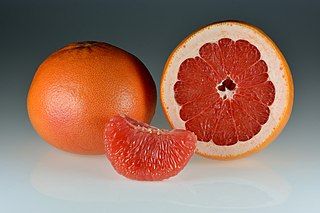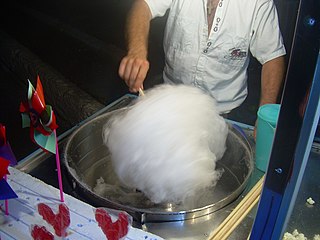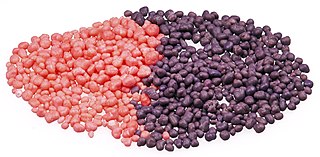
The almond is a species of tree from the genus Prunus cultivated worldwide for its seed, a culinary nut. Along with the peach, it is classified in the subgenus Amygdalus, distinguished from the other subgenera by corrugations on the shell (endocarp) surrounding the seed.

Kiwifruit or Chinese gooseberry is the edible berry of several species of woody vines in the genus Actinidia. The most common cultivar group of kiwifruit is oval, about the size of a large hen's egg: 5–8 centimetres in length and 4.5–5.5 cm in diameter. It has a thin, fuzzy, fibrous, tart but edible light brown skin and light green or golden flesh with rows of tiny, black, edible seeds. The fruit has a soft texture with a sweet and unique flavour.

The grapefruit is a subtropical citrus tree known for its relatively large, sour to semi-sweet, somewhat bitter fruit. The interior flesh is segmented and varies in color from pale yellow to dark pink/red.

Table grapes are grapes intended for consumption while fresh, as opposed to grapes grown for wine production, juice production, or for drying into raisins.

Feijoa sellowiana also known as Acca sellowiana (O.Berg) Burret, is a species of flowering plant in the myrtle family, Myrtaceae. It is native to the highlands of southern Brazil, eastern Paraguay, Uruguay, and northern Argentina. Feijoa are also common in gardens of New Zealand. It is widely cultivated as an ornamental tree and for its fruit. Common names include feijoa, pineapple guava and guavasteen, although it is not a true guava. It is an evergreen shrub or small tree, 1–7 metres (3.3–23.0 ft) in height.

Zinfandel is a variety of black-skinned wine grape. The variety is grown in over 10 percent of California vineyards. DNA analysis has revealed that it is genetically equivalent to the Croatian grapes Crljenak Kaštelanski and Tribidrag, as well as to the Primitivo variety traditionally grown in Apulia, Italy, where it was introduced in the 18th century, and Kratošija in Montenegro. The grape found its way to the United States in the mid-19th century, where it became known by variations of a name applied to a different grape, likely "Zierfandler" from Austria.

Cotton candy, also known as candy floss (candyfloss) and fairy floss, is a spun sugar confection that resembles cotton. It usually contains small amounts of flavoring or food coloring.

Nerds is an American candy launched in 1983 by the Sunmark Corporation under the brand name Willy Wonka Candy Company. Nerds are now made by the Ferrara Candy Company, a subsidiary of Ferrero Group. but is still distributed internationally by Nestlé. With their anthropomorphic covers, Nerds usually contain two flavors per box, each flavor having a separate compartment and opening.

V8 Vegetable Juice, sometimes simply referred to as V8, is a trademarked name for a number of beverage products sold worldwide that are made from eight vegetables, or a mixture of vegetables and fruits. Since 1948, the brand has been owned by the Campbell Soup Company.

Airheads is an American brand of the taffy candy owned by the Italian-Dutch company Perfetti Van Melle. They were created on August 7, 1985, by Steve Bruner. Airheads are available nationwide in the United States and Canada where the candy is available in 16 different flavors.

Garcinia madruno, the charichuela, is a fruit-producing tree species from the rainforests of Central and South America. The leaves are dark green and leathery. The fruit looks like a shriveled droopy lemon and has a similar rind, so is sometimes called a lemon drop mangosteen. The interior is soft white pulp and has a popular, slightly citrusy taste people have compared to a sweet santol fruit or lemony cotton candy. The species was formerly included in the genus Rheedia, which has since been absorbed into Garcinia, as Rheedias species are now known as "new world mangosteens".

Dekopon (デコポン) is a seedless and sweet variety of satsuma orange.

Mission grapes are a variety of Vitis vinifera introduced from Spain to the western coasts of North and South America by Catholic New World missionaries for use in making sacramental, table, and fortified wines. It is grown in South America, particularly in Chile and Peru, under the names Criolla and Pais. During the 19th century, the grape was known by several other names, including the Los Angeles grape, and the California grape.

'Ambrosia' is a cultivar of apple originating in British Columbia, Canada in the early 1990s. The original tree was first cultivated by the Mennell family of Similkameen Valley, British Columbia, who discovered it growing in their orchard.

Churchkhela is a traditional Georgian candle-shaped candy.

Coronation grapes are a hybrid variety of table grape developed in Canada. Coronation grapes are popular throughout Canada, and are available during a short period in late summer and early fall. These grapes are characterized by their "vibrant blue-purple" colour, similar to the related Concord variety.

Thomcord is a seedless table grape variety and a hybrid of the popular Thompson Seedless or Sultanina grape and Concord grape. Thomcord was developed in 1983 by Californian grape breeders working for the Agricultural Research Service (ARS), an agency of the United States Department of Agriculture (USDA), as part of a test to better understand a new seedless grape breeding procedure.

The propagation of grapevines is an important consideration in commercial viticulture and winemaking. Grapevines, most of which belong to the Vitis vinifera family, produce one crop of fruit each growing season with a limited life span for individual vines. While some centenarian old vine examples of grape varieties exist, most grapevines are between the ages of 10 and 30 years. As vineyard owners seek to replant their vines, a number of techniques are available which may include planting a new cutting that has been selected by either clonal or mass (massal) selection. Vines can also be propagated by grafting a new plant vine upon existing rootstock or by layering one of the canes of an existing vine into the ground next to the vine and severing the connection when the new vine develops its own root system.

International Fruit Genetics (IFG) is a private Bakersfield, California-based fruit breeding company that licenses patented breeds of fruit to growers worldwide. The largest breeder of table grapes has licensed one type of this fruit to Bakersfield-based grower Grapery, Cotton Candy.



















